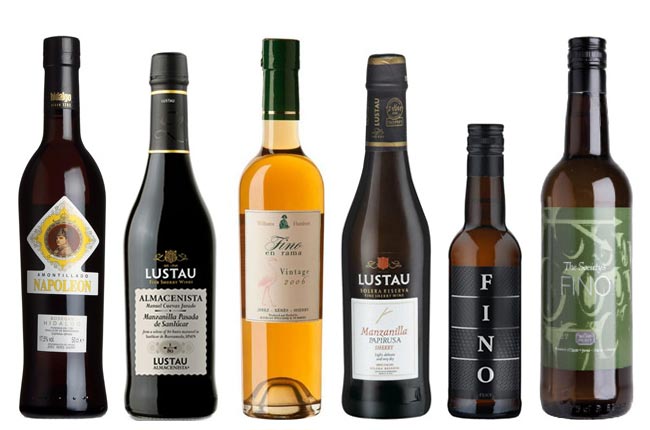Sherries are refashioning themselves as new, younger drinks. FIONA BECKETT finds out what's behind the change.
I’m in one of London’s most fashionable restaurants, Moro, with a chocolate and apricot tart and a glass of Valdespino Solera 1842 oloroso. It’s one of 10 premium sherries that proprietors Samuel and Samantha Clark have on their list. ‘We know that for some sherry is a dirty word but we have been swept away by the complexity of its tastes and the romance of its production,’ they enthuse in their bestselling book, Moro.
A couple of miles away in the City at the Fishmarket Bar in Terence Conran’s Great Eastern Hotel they have just extended a month-long promotion – a pairing of three different oysters with three brands of manzanilla – because it has been so successful. ‘One couple has been coming in every night,’ sommelier Steve Kirkham beams with satisfaction.The scenario, 30-somethings drinking sherry all over London, is every sherry producer’s dream; but, of course, things aren’t quite as rosy as that. These are isolated cases in a market where two thirds of consumers are over 65 and which is declining year by year. It takes more than a few enthusiasts to change things.
Change…
Not that sherry producers aren’t trying. It started seven years ago when Allied Domecq put its leading brand Harveys Bristol Cream in a blue bottle. More recently it has been pushing it as a drink to be served over ice with a slice of orange, an attempt to counteract the ‘bottle at Christmas’ buying pattern that bedevils the brand. It also changes the taste, making it drier and less syrupy. ‘The minute you put ice with it, people’s perception changes,’ says Neil Anderson, Harveys brand manager. ‘They see it as more summery and refreshing.’
Sandeman has gone down a similar route, relaunching its medium-dry amontillado, Dry Don as (according to the label) a ‘delightfully dry wine with just a hint of sweetness’. Sandeman recommends that it be served chilled or over ice. ‘A separate solera system has been set up to ensure that it tastes at its best cold,’ says company chairman George Sandeman. ‘We took a lot of care to ensure the flavours were not lost when it was chilled. We even suggest that people add a little bit of tonic or lemonade. I know to many people that’s a heresy but it’s perfectly authentic. The Spanish dilute their sherry when the weather’s hot.’
Gonzalez Byass has taken a different tack with Tio Pepe. Having less scope to modify the product it’s made a virtue of its austerity, marketing it like a premium white wine. The bottle has been completely redesigned with the grape variety and style – extra dry and palomino fino – emphasised at the expense of the word sherry. It’s been accompanied by a cryptic advertising campaign depicting social situations to be handled with tact such as ‘sophistication: the ability to yawn without opening your mouth’ and the pay-off line ‘always look on the dry side of life’.
Fiona Lovatt, brand manager for Tio Pepe, admits it’s been controversial but relishes the fact that her brand is being talked about. ‘We’re not trying to appeal to 18-year-olds. We’re trying to reach 30- to 40-year-olds who enjoy sophisticated foods such as anchovies and olives.’Generic campaigns are concentrating more on exploiting the affinity of dry sherry and food, particularly seafood. Promotions for manzanilla, for example, are being targeted at friendly seafood bars and restaurants like the Fishmarket at the Great Eastern. Again it makes no bones about playing down the ‘s’ word, a strategy that has proved successful in Spain, where 60% of the sherry consumed is manzanilla. The next step is to link it with sushi. ‘We’ve already done trials and found it goes down particularly well,’ says UK PR consultant Fiona Campbell, who has been handling the campaign.Common to these approaches is the idea of serving sherry cold and in appropriate glasses. ‘A lot of our activity has been focused on getting Tio Pepe served straight from the fridge, in a wine glass, to change the image people have of a sticky liquid in a schooner,’ says Lovatt. Sandeman agrees. ‘Drinking sherry in a wine or a highball glass makes people feel more comfortable. Copitas work extremely well in Jerez but that’s about the only place. I’ve even got friends who serve it in a Riedel Champagne flute. It makes it look very different and gives it an attractive, contemporary look.’
Aged sherries for connoisseurs
The other sector of the market in which producers are interested is releasing rare aged sherries for connoisseurs – this isn’t a new strategy but they believe it will help to raise the overall image of the sector. Much effort is being made to get them into Michelin-starred restaurants, and The Fat Duck’s proprietor Heston Blumenthal is already a big sherry fan. As more consumers visit Jerez for themselves, producers believe the task of selling authentic Spanish sherries will become easier. Spanish names have a resonance that the English ones lack, reckons James Sankey, who is opening a new bar and restaurant, Oloroso, in Edinburgh. He admits he chose the name because it sounded good, ‘although we will, of course, carry the idea through. We plan to serve at least 12 sherries to start with and build up to about 24. All you have to do to sell sherry is to put the idea in front of people. Once they taste it it’s amazing how often they come back.’ ‘What we’re saying to people who associate sherry with little old ladies is that the reality is it has much more flexibility and a far greater range of flavours than they’re aware of,’ says George Sandeman. ‘Just like wine.’





